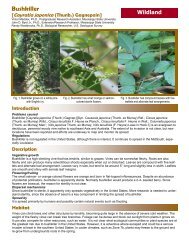RATopic1_95 - Geosystems Research Institute - Mississippi State ...
RATopic1_95 - Geosystems Research Institute - Mississippi State ...
RATopic1_95 - Geosystems Research Institute - Mississippi State ...
You also want an ePaper? Increase the reach of your titles
YUMPU automatically turns print PDFs into web optimized ePapers that Google loves.
Task 3.3. Opuntia and Cactoblastis Habitat Models and Population Genetics<br />
PI: Gary N. Ervin<br />
Co-PI: John Madsen, Richard Brown<br />
Collaborators: Chris Brooks, Lisa Wallace,<br />
and Mark Welch; MSU Biological Sciences<br />
Modeling of Pricklypear Cactus and Cactus<br />
Moth Habitat<br />
Gary N. Ervin<br />
Our proposed work for 2009-2010 encompasses<br />
three major areas of research – experimental<br />
studies of growth performance of C.<br />
cactorum and native US cactus moths on native<br />
southeastern US Opuntia species, genetic<br />
studies of Opuntia and cactophagous<br />
moths, and C. cactorum habitat modeling<br />
efforts.<br />
Experimental studies<br />
Growth chamber experiments continue, as of<br />
December 2009, with both C. cactorum and<br />
Melitara prodenialis nearing the ends of their<br />
life cycles (Figure 1). Preliminary analyses suggest differential performance of these moths on the native Florida cacti<br />
(O. humifusa and O. stricta), and those data are being used as the basis for an NSF grant proposal to be submitting in<br />
January 2010. That proposal aims to fund molecular genetic work to identify mechanisms of interaction between moths<br />
and host plants. The proposal submission will involve collaborative work with Dr. Travis Marsico of Arkansas <strong>State</strong><br />
University; Marsico was a post-doc sponsored on this research.<br />
We began quarterly field observations in January 2009 to complement the growth chamber studies. The objectives were<br />
to determine patterns and outcomes of M. prodenialis<br />
and C. cactorum feeding on O. humifusa<br />
and O. stricta. Of the ninety-three O. humifusa<br />
plants observed, only one was fed upon by C.<br />
cactorum alone, one was fed upon by both C.<br />
cactorum and M. prodenialis, but M. prodenialis<br />
fed upon eighteen plants by itself. Of forty-nine<br />
O. stricta plants observed, C. cactorum fed upon<br />
twenty. On average, Opuntia plants without<br />
moth herbivory or with herbivory from the native<br />
M. prodenialis grew during the study (Figure 2).<br />
In contrast, plants with C. cactorum herbivory<br />
decreased in size because plant growth did not<br />
compensate for losses due to moth herbivory.<br />
Figure 2. Changes in Opuntia host plant size from field-monitored individuals<br />
in Florida, between January and October 2009. Growth measured as number<br />
of cladodes per plant for plants with no feeding from moths (left), feeding by<br />
C. cactorum (center), or feeding by M. prodenialis (right). Different letters<br />
above bars indicate significant difference, based on one-way ANOVA and a<br />
Tamhane post-hoc test to determine significant differences at p




